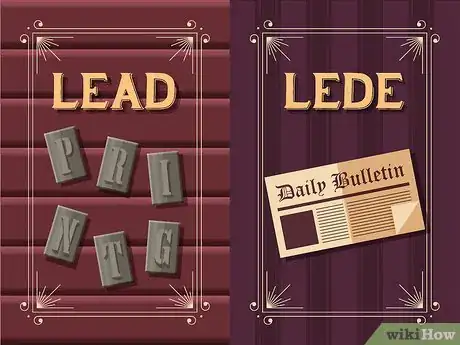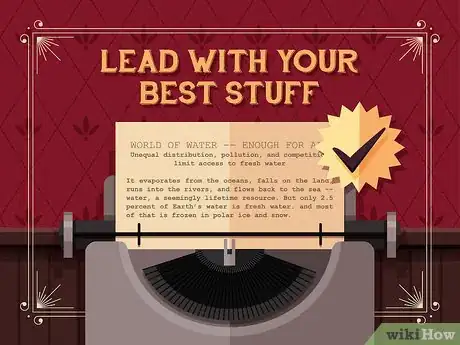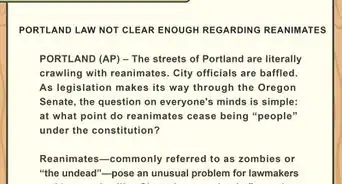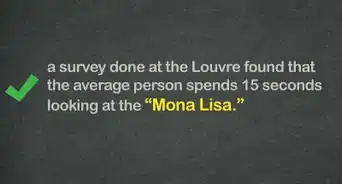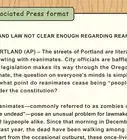wikiHow is a “wiki,” similar to Wikipedia, which means that many of our articles are co-written by multiple authors. To create this article, 17 people, some anonymous, worked to edit and improve it over time.
wikiHow marks an article as reader-approved once it receives enough positive feedback. In this case, several readers have written to tell us that this article was helpful to them, earning it our reader-approved status.
This article has been viewed 109,367 times.
Learn more...
Writers of news stories generally utilize a special style and format in crafting their opening lines. This is known as the lead (or lede). Even as the preeminence of newspapers declines in the face of competition from newer technologies, the methods for writing an effective lead are still widely taught and used. They also provide valuable insights for any writer.
Steps
Understanding a Lead
-
1Know a "lead" from a "lede." In fact, they are the exact same thing. The use of "lede" dates back to when newspaper publishers needed to differentiate between the term used for the beginning of a news story and the molten lead (the metal) used in the printing process.
-
2Lead with your best stuff. A news story lead is based on the premise that you need to save the best for first. It has to catch the reader's eye and succinctly provide the most important information about the article.
- The phrase "burying the lead" (or "lede") refers to delaying or withholding the most vital information. For example, if a teenager tells his mother he cleared out some more space in the garage like she asked but fails to mention he did so by totaling the car, that's burying the lead.
Advertisement -
3Worry about the lead, not the conclusion. Unlike essays or books or most other forms of writing, news articles are written on the assumption that the reader may not finish the piece.
- Newspaper readers often skim only the beginnings of stories, and editors often trim off the ends of stories before they ever go to press, so the focus is on the lead, not on building up to a fantastic conclusion.
- News stories usually use what is called an inverted pyramid structure, where the weightiest, most substantial information is on the top, and the least substantial elements are at the bottom.[1]
Writing a Lead
-
1Provide the 5 "W's" and "H." A traditional lead attempts to answer most or all of the key questions -- Who? What? When? Where? Why? and How?
- For example: "A faulty space heater caused a raging fire in the 400-block of Grant Street last night around 2 am, leaving two firefighters hurt and three families homeless."
-
2Keep it short. While the exact numbers vary, journalism students are often taught to write first sentences of between 25 and 35 words, and not more than 40. This is considered just long enough to provide, in most cases, the vital details in a succinct manner.
-
3Focus on action. Readers are drawn in by active sentences that highlight the stakes, the conflict, or the impact of the event covered, propelling them forward into the story.
- A form of sentence editing called the Paramedic Method involves identifying and eliminating redundancies and use of the passive voice in favor of sentences using simple verbs with the "doer" as the subject.[2]
- As an example of the Paramedic Method, compare "The highest office in the nation was granted once again to John Doe by the voters last night" with "Voters granted John Doe another turn in the nation's highest office last night."
-
4Break the rules when inspiration strikes. A writer is more artist than scientist, so however hard and fast the rules may seem for leads, high-quality exceptions to the standard abound. Some variations include:
- Asking a question -- "Who could have guessed a single phone call two years ago would bring down the city's most famous banking family?"
- Using an anecdote -- "From Amy Smith's raucous nosebleed seat high above Ajax Field, the kick looked perfect; yet the barely-visible referee's arms refused to rise in agreement."
- The delayed lead, which can use questions, anecdotes, or other methods to draw readers in without immediately revealing details. This, however, tends to work better in longer features than "hard news" stories.[3]
-
5Consider the benefits of leads for all writing. What writer, from a high-schooler with a book report due to a grizzled novelist, cannot benefit from thinking about providing critical initial details in a concise and active manner that draws the reader into the work?
Community Q&A
-
QuestionAre headlines the same as lead? Can you give some examples?
 Community AnswerNo, they are not. A headline is like a caption, and a lead is more like a sentence starter. "Dogs loose in the city" is a headline, and "I have noticed there are dogs loose in the city, here is some more info" is a lead.
Community AnswerNo, they are not. A headline is like a caption, and a lead is more like a sentence starter. "Dogs loose in the city" is a headline, and "I have noticed there are dogs loose in the city, here is some more info" is a lead. -
QuestionHow many paragraphs will be in a lead?
 MushyKetchupCommunity AnswerJust one. In fact, a good lead should be only one or two sentences. A second paragraph of supplementary facts is allowed if all information can't be squeezed into the lead.
MushyKetchupCommunity AnswerJust one. In fact, a good lead should be only one or two sentences. A second paragraph of supplementary facts is allowed if all information can't be squeezed into the lead. -
QuestionWhat should come after the lead?
 MushyKetchupCommunity AnswerThis depends on style. Sometimes, a second paragraph with supplementary facts is necessary. Other times, this second paragraph will be skipped in favor of a quote. It largely depends on situation and stylistic preferences.
MushyKetchupCommunity AnswerThis depends on style. Sometimes, a second paragraph with supplementary facts is necessary. Other times, this second paragraph will be skipped in favor of a quote. It largely depends on situation and stylistic preferences.
